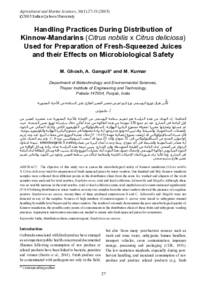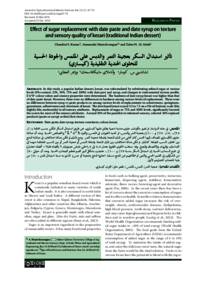Document
Handling Practices During Distribution of Kinnow-Mandarins (Citrus nobilis x Citrus deliciosa) Used for Preparation of Fresh-Squeezed Juices and their Effects on Microbiological Safety.
Contributors
Ganguli, A., Author
Kumar, M., Author
Publisher
جامعة السلطان قابوس. كلية العلوم الزراعية والبحرية
Gregorian
2005
Language
English
English abstract
The objective of this study was to assess the microbiological safety of Kinnow-mandarins (Citrus nobilis X Citrus deliciosa) used for preparation of fresh squeezed juices by street vendors. One hundred and fifty Kinnow mandarin samples were collected from different points in the distribution chain from the same lot, washed and aliquots of the wash samples were analyzed for total aerobes, Staphylococcus, total and fecal coliforms, Salmonella and Shigella. Although, there was no notable increase in the total aerobic, total or fecal coliform counts, total staphylococcal counts increased significantly) P<0.05) during distribution to street vendors; seventy-two samples from the street vendors showed the presence of coagulase positive Staphylococcus aureus, twenty-three of these produced enterotoxins B and C. Salmonella and Shigella were not detected in any of the samples. Sources of high numbers of enterotoxigenic S. aureus were traced to unhygienic manual handling by middle level buyers and by street vendors. The results of our study demonstrate the poor microbiological quality of Kinnow-mandarins, the possible entry points of contaminants in the distribution chain of these fruits and unhygienic vending practices. Appropriate intervention measures are needed to ensure safe fresh squeezed juices for consumers.
Member of
ISSN
2410-1079
Resource URL
Citation
Ghosh, M., Ganguli, A., & Kumar, M. (2005). Handling Practices During Distribution of Kinnow-Mandarins (Citrus nobilis x Citrus deliciosa) Used for Preparation of Fresh-Squeezed Juices and their Effects on Microbiological Safety. Agricultural and Marian S
Arabic abstract
إن الهدف من هذه الدراسة هو لتقييم سلامة اليوسفي من الإصابة بالأحياء المجهرية عند تحضيره كعصير من قبل الباعة في الشارع . لقد تم جمع 150 نموذجا من هذه الفاكهة من عدة أماكن خلال سلسلة توزيع نفس الشحنة، حيث تم غسلها وتحليلها مخبريا لمعرفة مجموع البكتريا الهوائية، الستافيلوكوكاس، الكوليفورم الكلي وكذلك المتأتي من التلوث بالفضلات، السالمونيلا، والسيحة. وقد تبين أنه ومع عدم وجود أية زيادة ملحوظة في مجموع البكتريا الهوائية والكوليفورم بنوعيه فأن نسبة الستافيلوكوكاس قد ارتفعت بصورة إحصائية مهمة (0.05 > P) خلال عملية التوزيع على محلات البيع. لقد وجد إنريم كوأحيوليز المنتج من الستافيلوكوكاس في 72 نموذج وكان 23 منها قد أنتحب أنتيروتوكسين نوع C , B. ولم يتم التعرف على أية مصادر للسالمونيلا والشيجلا في أي نموذج، بينما وجدت أعداد كبيرة من مصادر enterotoxigenic S aureus نتيجة للتداول اليدوي غير الصحي لدى الباعة من الطبقة المتوسطة وفي الشارع. يتبين نتيجة هذه الدراسة مدى رداءة وسائل الوقاية من التلوث الميكروبي لفاكهة اليوسفي واحتمال حصول هذا التلوث أثناء عمليات التوزيع وكذلك بسبب قلة وسائل الوقاية لدى الباعة في الشارع. ولذا فأننا نرى ضرورة اتخاذ الإجراءات اللازمة والملائمة للتأكد من سلامة العصير وخلوه من التلوث وبالتالي تقديم عصير طازج سليم صحي.
Category
Journal articles


